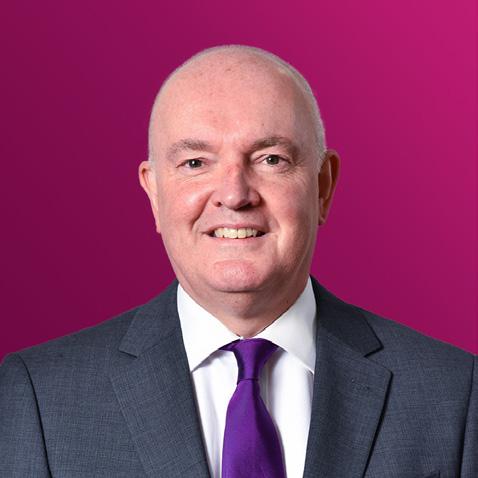
update Q2 2024
Your investment
This document has been produced by Seven Investment Management LLP from internal and external data. Any reference to specific instruments within this document are part of widely diversified portfolios and do not constitute an investment recommendation. You should not rely on it as investment advice or act upon it and should address any questions to your financial adviser. The value of investments can vary and you may get back less than you invested. Tax rules are subject to change and taxation will vary depending on individual circumstances.
Contents Welcome Conflicting signals
Martyn Surguy Chief Investment Officer Strategy
The 'Global ISA'?
Ahmer Tirmizi Head of Fixed Income Strategy
Special feature
Seven Insights from 7IM
Hugo Brown
Quantitative Investment Strategist, Alternatives
Duncan Blyth
Head of Private Client Portfolio Management
Jack Turner
Head of ESG Portfolio Management
Sam Hannon Investment Associate
Ahmer Tirmizi
Head of Fixed Income Strategy
Tony Lawrence
Head of Model Solutions
Terence Moll
Head of Investment Strategy
Culture & Sustainability
The environment's got beef with burps
Wenqian Zeng
Junior ESG Investment Analyst
Visit us at
to find out more about our latest news and views. 04 06 10 12 Your Investment Update – Q2 2024 3
www.7im.co.uk
Welcome
Conflicting signals
Financial market behaviour does not conform to neat calendar year compartments. Even though we know that, our brains remain in the habit of using a calendar year lens to review performance and investment strategy. 2024 so far is a prime example of the folly of expecting different conditions to arise as the clock ticks into the New Year.
Economic concerns have failed to materialise. Inflation has remained stubbornly high and central banks remain on hold. Perhaps surprisingly, stock market leadership has been retained by an extraordinarily concentrated number of stocks (the “Magnificent Seven” in the US and the 11 “Granolas” in Europe). Surely something has to give soon? Stock markets seem to be simultaneously priced for the softest of soft landings for the global economy but also the type of monetary easing only really likely if the economy hits the rocks.
On the quarterly scorecard, returns have been positive across the board which is encouraging. But the residual feeling is one of disappointment as many of our views have not come to pass… yet. We retain conviction that a diversified approach will win out over time, and we are alert to the dangers of chasing past winners. The timing of a change in market behaviour is notoriously difficult to predict. Most probably, it will happen for reasons we least expect which are not currently on anyone’s radar.
4 Your Investment Update – Q2 2024
We retain conviction that a diversified approach will win out over time, and we are alert to the dangers of chasing past winners.”
A broadening of economic leadership from the US to other parts of the world is what we expect. A broadening too of stock market leadership from an incredibly short list of companies to less well owned and better value areas seems likely. We are positioned for both. Discipline and patience will be the key, however uncomfortable that may feel at the moment, as we watch an extremely limited number of stocks head for the stratosphere. We are determined to be prudent stewards of our clients’ capital.
The imperative of proper diversification to deliver both attractive returns and a smoothed investment journey is a theme captured by Ahmer Tirmizi. All may not be as it seems when looking at the label, as he explains. Elsewhere, we have experimented by setting out seven bite-sized commentaries to capture our thoughts on a range of issues. I hope you enjoy them.
As always, we welcome feedback on our publications. Thank you for reading.
MARTYN SURGUY
Chief Investment Officer

5 Your Investment Update – Q2 2024
Strategy
The 'Global ISA'?
Knowing where, when, and how to invest can be confusing. Economic variables are hard to forecast, random shocks (like Covid-19) come out of nowhere and markets react to these events in seemingly unpredictable ways. And if that wasn’t enough, governments across the world are trying control these factors that are sometimes uncontrollable.
China, until very recently, has made a huge success of it. Its astonishing economic development over the last few decades owes a large part to deliberate government intervention. This is starting to reverse, though, with investors shying away from Chinese equities. This hasn’t stopped that free-market America giving it a go – as the recent CHIPS and Science Act looks to encourage onshore advanced technology production.
Closer to home, we were interested to see the so-called ‘British ISA’ announced. It looks like we will be given an extra £5,000 allowance (on the top of the existing £20,000), where the allowance is reserved for ‘UKfocused assets’. On the surface, this sounds straightforward – the UK government wants to channel more investment into shares issued by any company incorporated in the UK and listed on a UK-recognised stock exchange.
Whether it will have the desired effect remains to be seen, but it won’t be easy to implement. Encouraging investors to target their capital into a specific region comes with its own challenges. If investing can be confusing, then concentrating that investment in one region may just add to that confusion. We tend to believe client investments should remain diversified across regions and other market drivers.
To see why we think this, let’s ask ourselves a simple question… what exactly is a ‘UK-focused asset’?
6 Your Investment Update – Q2 2024
Country of listing ≠ Country of exposure
Looking to support growth of UK businesses and the UK economy is the aim of every government, but the reality of investing via a ‘British ISA’ could look very different. Take the FTSE 100 (the largest companies listed in the UK). And let’s specifically look at Company ‘X’, which is one of the largest companies at a weight of around 5%. This company, according to its 2022 report, generates around 96% of its revenues outside of the UK, despite being listed in the UK.
Put another way, if you invested the extra £5,000 allowance into this company, £200 would be invested into a company where just 4% of its workforce are employed in the UK. There are even examples of companies with no revenues or employees in the UK! When combined the largest 100 companies listed in the UK, the portion of total revenues generated in the UK is about 20%. Is this what the government has in mind when it decides what a ‘UK-focused asset’ is?
Exposures come in different forms
The UK is not alone, though. The largest companies in any given equity market will tend be global in nature. These exposures can change through time in unpredictable ways. This is why we prefer to put together a globally diversified exposure of equities which together come closer to what is a sensible global exposure. For instance, 7IM portfolios show significant exposure to the US, which makes sense as the world’s largest economy, but this doesn’t come from investing in companies just listed in the US but rather through revenues from European, Chinese, and South African-listed companies. We can apply this logic to different types of market drivers as well. Think sectors: in any given period, particular types of sector exposures can give you different results. Are oil prices rising? Then maybe the energy sector is the place to be. Is the economy slowing?
Stable healthcare companies might offer some protection. How strong is global trade? Industrial companies will provide some exposure to the ups and downs. The challenge is that, predicting oil prices or the economy or trade or any other variables is not easy. Instead, a more prudent approach is to ensure risks are spread evenly, rather than overly concentrated in one area. Staying diversified will ensure some exposure to some of the most positive outcomes, while mitigating the outcomes of the worst. No one could predict that Russia would invade Ukraine in 2022, but those who had some exposure to energy companies (ironically, most likely through the FTSE 100) would have been glad they did. >>
Head of Fixed Income Strategy

TIRMIZI
AHMER
7 Your Investment Update – Q2 2024
Combining different types exposures win out in the long run
The challenge to staying diversified is when one particular sector, market or theme appears to dominate everything else. We saw this with oil companies in the 70s, Japanese companies in the 80s and emerging markets in the mid-2000s. Today, we are seeing a smaller and smaller subset of companies, usually referred to as ‘Tech’, leading equity markets higher. The temptation is to ask, why bother diversifying?
NB: strictly the companies in question are in the IT, Consumer Discretionary and Communication Services sectors … another reason to diversify across sectors!
In those previous instances, the concentrated themes eventually reversed course. Not because they were led by bad businesses or those sectors don’t exist anymore or the regions they were in fell behind. It was just that the market started preferring something, anything else. We can see this in the way concentration of particular sectors have evolved through time (see Market leaders change frequently section ahead). The market concentration of those leaders changing from decade to decade shows how things can change.
Right now, away from the UK, investors are deliberately increasing their concentration in a narrower and narrower subset of companies.
Investing can be simple though
Thinking about all the different dimensions to investing can be overwhelming. The regions and sectors are just the start. There are so many other factors. From local government regulations to national trade deals, from currencies to interest rates, there can be a lot to take in. The best and simple remedy to this is to spread investments across as many of these different market drivers as is reasonable. It might not feel like this when the headline-grabbing investments are leading the way, but you’ll be glad you did when it turns. And if history is anything to go by, it usually does.
So, the government will have to think hard about how it implements the ‘British ISA’. Steering investors towards a small subset of UK-listed companies won’t be as easy or as desirable as it sounds. Given the global exposure of UK-listed assets, it may end up looking more like a ‘Global ISA’, in which case why just invest in the UK? Instead diversify across multiple regions, just like 7IM portfolios?
Market leaders change frequently
When someone is new to investing, the question they tend to ask is ‘where should I invest my money?’, usually hoping for some insight into the next big thing to profit from. The answer though should be more boring than that… everywhere. While it is tempting to ride the latest excited wave in investments, the forgotten bit is how things can change. Yes, Japanese companies were the best performing in the 80s… but then spent the next two decades lagging everything else. The chart below shows how different leaders have changed through the decades. Timing when this changes is difficult, so having investments spread across different regions and drivers is the most profitable way to invest over the long run.
Strategy Continued
8 Your Investment Update – Q2 2024
If investing can be confusing, then concentrating that investment in one region may just add to that confusion. We tend to believe client investments should remain diversified across regions and other market drivers.”
Leaders from each era had a smaller market weight a decade later Darker shades indicate weight of 10 largest stocks at peak concentration (dates noted in article). Lighter shades indicate weight of the same 10 securities one decade later.
Source: MSCI
Weight in MSCI World (%) 0 5 10 15 20 25 1970s US Blue Chips Global Oil Majors Japan Financials Internet Origins AI Onset 1980s 1990s 2000s 2023 ?
9 Your Investment Update – Q2 2024
Seven Insights from 7IM Special feature

Can one factor explain markets?
Hugo Brown
Quantitative Investment Strategist, Alternatives
As Ahmer noted this quarter, markets are driven by a huge number of factors. This doesn’t stop investors narrowing markets down to one relationship. Take the chart below, which has been referenced in various financial media outlets. It appears to show a strong relationship between global equities and global commodity prices (excluding energy).
Theoretically, this makes sense… economic growth is a significant driver of equity market returns.
What leads and what follows?
As the economy grows, so do company profits. That same growth tends to push up demand for more materials to manufacture more goods. This demand for materials leads to upward price pressures.
Some financial commentors have noticed a change in the relationship (see chart). Taking it through to its logical conclusion, the implication is that there might something amiss in markets. Are commodity markets suggesting the global economy is slowing? Are equity markets ignoring the messages coming from the commodity markets? Should equity investors run for the hills?
Global commodities (excluding energy) vs global equities, rebased 100 = February 2019
The relationship with the two is more complicated than implied. Look again, but this time a rolling correlation chart. This measures the relationship between the two over time. What you can see is how correlation can change over time versus an “average” over the whole period.
Sometimes commodities can be a significant driver of markets, other times they might not. Over the last couple of years, that relationship has moved up, but from extremely low levels. What is notable is how changeable that is. The lesson is to be wary of the claim of just one factor driving markets. In reality, it’s never that straightforward.
Source: Bloomberg Finance L.P.
1
Returns 60.00 2020 2021 2019 2023 2024 2022 80.00 100.00 120.00 140.00 160.00 180.00 MSCI World Base Metals 200.00
10 Your Investment Update – Q2 2024
Rolling correlation
Source: Bloomberg Finance L.P.
Keeping up with the Kardashians
Duncan Blyth

Head of Private Client Portfolio Management
Weight loss and obesity drugs have dominated headlines in the healthcare sector, but drugs like Wegovy are now all over popular mainstream media. What started as a research project into diabetes treatment in 1970 then led to the discovery of blood sugar regulating hormone GLP-1 in the 1980s. An unexpected side effect of this discovery was weight loss, which has led into treatments to tackle obesity… and it’s become the Kardashians’ worst kept secret.
The main companies operating in this area are Danish pharmaceutical business Novo Nordisk and Eli Lilly in the US. Recent announcements have also indicated these drugs can reduce the risk of heart attacks, strokes and kidney disease. The share prices of both companies have risen more than fivefold over the last five years.
This is great news for society (and shareholders of Novo Nordisk and Eli Lilly), but has been less good for healthcare businesses that make drugs and devices that treat these chronic conditions. This includes companies that manufacture glucose monitors, insulin pumps, CPAP machines for sleep apnea and dialysis machines. Share prices across the sector have been very volatile around medical updates, and even Walmart referenced the drugs and noted customers were cutting on high-calorie products.
As tempting as it is to own one of two winners, being able to predict the beneficiaries of a piece of news, or the timing of it, is difficult. This is why, as noted by Ahmer, we prefer spreading exposures rather than concentrating them. Over time, the stronger parts will counter the weaker parts, and benefit the healthcare sector as a whole. >>
Source: Novo Nordisk 2024 Capital Markets Day – 3rd March 2024 https://www.novonordisk.com/investors/capital-marketsday-2024.html
2
Correlation Average Correlation Rolling Correlation 0 0.1 0.2 0.3 0.4 0.5 0.6 0.7 0.8 2001 2006 2011 2016 2021 11 Your Investment Update – Q2 2024
Special feature

Big Tech becoming Clean Tech
Jack Turner
Head of ESG Portfolio Management
After years of flat line growth, electricity demand is spiking in the US and is expected to continue trending higher. Data centres are the main culprits, with investment likely to exceed $150bn through to 2028. And this estimate could be on the low side.
Artificial intelligence, Machine Learning, Big Data, Cryptocurrencies, and every other buzzword you’ve heard of is extremely energy-intensive. This leads to very large data centres, with the largest in the world, based in Nevada, being twice the size of Heathrow Airport!
Top corporate clean energy buyers, 2023
Amazon
Meta
LyondellBasell
Google
Tata Steel
Air Liquide
Albras
Albert Heijn
Microsoft
Orange
Source: Bloomberg Finance L.P.
Because of where they are based, many of these data centres run on renewable energy and that means IT companies are becoming the biggest buyers of renewable energy. As the table below shows, Amazon stands out amongst other corporates, having purchased 8.8GW of electricity in 2023. This is a huge amount and means it has the eighth-largest renewable energy portfolio in the world, larger than many existing utility companies.
0 1000 2000 3000 4000 5000 6000 7000 8000 9000 10000
MW
Continued 3
12 Your Investment Update – Q2 2024
The internet supply chains

Sam Hannon, Investment Associate
There’s been a large focus on global supply chains in recent years. First, Covid-19 led to a squeeze on manufactured goods. Then Russia was cut from global commodity networks. And now, conflict in the Middle East has cut shipping routes through the Suez Canal. These events have been the main reason inflation across the world has spiked and remained elevated.
No wonder that global supply chains are thought of as essential to the functioning of the global economy. What is less known is that the supply chain is not just in goods but more and more in data. 99% of the world’s data is transported via underwater cables, including some $10tr of financial transactions via the Swift system, which manages global bank transactions.
With the rise of cloud-based computing and AI data generation - transmission via the near 500 million miles of underwater cable will become even more important to global growth. >>
Source: www.submarinecablemap.com
What is less known is that the supply chain is not just in goods but more and more in data.”
4
13 Your Investment Update – Q2 2024
5

It's not easy being a central banker
Ahmer Tirmizi
Head of Fixed Income Strategy
“In many respects the things are returning more to their state in 2019, which we can think of as normal for this purpose, that's job openings and quits, and surveys of workers.” Jerome Powell, Federal Reserve Chair, 20 March, 2024
Whatever “job openings and quits” are, they must be important. After all, the chairman of the Federal Reserve mentioned it in his latest press conference. And it is what it sounds like – it’s a survey of companies reporting the amount of ‘Help Wanted’ signs they have in their shop windows. It makes sense for Powell to be interested. After all, he is tasked with keeping inflation down while keeping employment up. He needs to know
how desperate companies are for new workers. But how reliable is the data? It’s a survey of 21,000 businesses in a country made up of over 30 million. While this might sound too little, it’s understandable. After all, this helps with the data being timely – imagining surveying millions of companies every month! Great care is taken to make sure the right mix of companies are being surveyed that represent the country as a whole.
But something curious has happened recently: the portion of respondents has fallen dramatically. A decade ago, around 70% of those surveyed were informing us of their job openings data. This has now fallen to around 30%. The reasons for this are unclear, but it seems to have taken a step-change after Covid-19. Whatever the reason, though, this signifies how difficult it is for central banks. Trying to predict the future impact of monetary policy on the economy is hard enough as it is. But understanding what the impact of it is in real-time is also extremely difficult, especially if the data is based on a smaller and smaller sample of the population.
Source: Bloomberg Finance L.P.
Special feature Continued Job openings and labour turnover survey % of respondents 20 30 40 50 60 70 80 Jan-14 May-14 Sep-14 Jan-15 May-15 Sep-15 Jan-16 May-16 Sep-16 Jan-17 May-17 Sep-17 Jan-18 May-18 Sep-18 Jan-19 May-19 Sep-19 Jan-20 May-20 Sep-20 Jan-21 May-21 Sep-21 Jan-22 May-22 Sep-22 Jan-23 May-23 Sep-23
14 Your Investment Update – Q2 2024
6
A new new normal?
 Tony Lawrence Head of Model Solutions
Tony Lawrence Head of Model Solutions
Some investors can be led to believe that what is happening today is the best predictor what will happen tomorrow. There’s some sense to this –after all, it’s difficult to predict the future. But you can see how this might come unstuck. In the 70s, it felt like inflation was never coming down. In the 80s, it seemed Japan’s economic and business customs were going to change the world. The 90s became synonymous with ‘.com’ bubbles. The 2000s convinced investors that China’s economic growth miracle would go out as far as the eye could see. We all know how those assumptions ended.
They all appear ‘normal’ until they don’t.
In the 2010s? The new normal was that low interest rates would continue ad infinitum. Inflation was permanently low and central banks would never hike again. So much so, that some countries even dabbled with negative interest rates. This year, as of March, Japan finally hiked interest rates above zero, taking up the remaining few negative-yielding bonds with it.
What will be the new new normal 2020s? We’re only four years in, so we’ll have to wait to find out. >>
Market Value (million, USD) of global negatively yielding debt
20000000
31/12/200931/12/201031/12/201131/12/201231/12/201331/12/201431/12/201531/12/201631/12/201731/12/201831/12/201931/12/202031/12/202131/12/202231/12/2023
Source: Bloomberg Finance L.P.
USD 0 2000000 4000000 6000000 8000000 10000000 12000000 14000000 16000000 18000000
15 Your Investment Update – Q2 2024
Special feature Continued

… and now, for something completely different.
7
Novel ways to use AI
Terence Moll Head of Investment Strategy
Einar Felix Hansen is a marvel, a wonder of the modern world. Between March and September 2023, he and his collaborators published a phenomenal 124 history books on Amazon. That must be the most productive seven months for any historian ever.
Except… his writings are vague, repetitive and vacuous! Look at some titles:
The History of Japan: Contrasts and Similarities Between Traditional and Modern Japan [ouch]
The History of the Maldives: From the Ancient Buddhists to the Modern Tourists [snore]
The History of Romania: From Vlad to Dracula [they’re the same person]
I suspect the mysterious Einar asks ChatGPT for big themes in the history, geography and culture of a country, then requests a twopage essay on each. He pastes them into a document and voilà!
Amazon is flooded with nonsense books produced with AI. Before you buy, it’s more important than ever to check the publisher, author, reviews, and writing samples. Einar gonna get you otherwise!
Amazon is flooded with nonsense books produced with AI. Before you buy, it’s more important than ever to check the publisher, author, reviews, and writing samples.”
16 Your Investment Update – Q2 2024
Culture & Sustainability
The environment’s got beef with burps
Recently I took advantage of the rare winter sun in the UK by taking a long stroll in the beautiful Surrey countryside. Amongst the rolling green hills, I saw cows grazing peacefully, providing me with a dose of rural charm (and milk and cheese!). What did not cross my mind in this serene environment was the amounts of methane being emitted around me.
When you think about climate change, you probably think about giant smokestacks or traffic on the M25. But how about a field full of cows, or even, a field of burping cows?
Contrary to common belief, most of the methane gas that a cow emits is released by burping rather than breaking wind. The International Energy Agency has reported that agriculture is the largest source of methane emissions. And the main culprit? Cow burps.
Astonishingly, there is about one cow to five persons in the world. That’s a lot of burps! The reason being that cows have a specialised stomach that helps them break down plant material which produces methane as a byproduct.
Methane, the silent villain, is a greenhouse gas that is 25 times better at trapping heat than its
famous counterpart, carbon dioxide. It is so potent that it is often considered better to burn the natural gas, which releases carbon, than let it escape into the atmosphere! Thankfully, methane is relatively short-lived, breaking down in the atmosphere in 12 years.
Now, let’s not put all the blame on cows. Oil and gas operations, as well as landfill waste, are also significant contributors of methane leaks.
Scientists and global leaders have been struggling to solve the methane “cownundrum”.

More than 150 countries have joined the voluntary Global Methane Pledge, aiming to reduce global levels by at least 30% by the end of the decade, and it sure was a hot topic in COP 28.
Several solutions have been invented, from adding seaweed to cow feed and burp-catching cow masks, to cutting-edge technologies such as new satellites designed to detect and monitor methane leaks.
Next time I walk in the countryside, I'll be sure to keep my affection of these gas giants at bay.
Junior ESG Investment Analyst WENQIAN ZENG
17 Your Investment Update – Q2 2024

Meet the teams Investment Management Team










Martyn Surguy Chief Investment Officer
ACA Chartered Accountant, MCSI, CISI Level 4, 37 years of industry experience.
Matthew Yeates Deputy Chief Investment Officer
CFA, FRM, BA Economics, 13 years of industry experience.
Uwe Ketelsen Head of Portfolio Management
MEcon, CFA, 28 years of industry experience.
Terence Moll Head of Investment Strategy and ESG
MPhil, PhD. in Economics, 33 years of industry experience.
Duncan Blyth Head of Private Client Portfolio Management
BSc Actuarial Mathematics & Statistics, CFA, 28 years of industry experience.
Hugo Brown Investment Analyst – Alternatives
BEng, CFA level 3 Candidate, 6 years of industry experience.
Ross Brydon Investment Implementation Manager
BA in Finance, 6 years of industry experience.
Christopher Cowell Senior Quantitative Investment Strategist
MSc, PhD, CFA, 8 years of industry experience.
Sam Hannon Investment Associate IMC and IAD. 6 years of Industry experience.
Tiziano Hu Quantitative Investment Strategist – Multi Asset
MSc in Financial Technology, 4 years of industry experience.








Ben Kumar Head of Equity Strategy
CFA, MSc Behavioural Economics, 12 years of industry experience.
Tony Lawrence Head of Model Solutions
CFA and CAIA, 23 years of industry experience.
Stephen Penfold Senior Investment Manager
BSc in Economics & Computing, 38 years of industry experience.
Peter Sleep Senior Investment Manager
32 years of industry experience.
Ahmer Tirmizi Head of Fixed Income Strategy
MSc in Economics and Finance, 17 years of industry experience.
Jack Turner Head of ESG Portfolio Management
CFA, 16 years of industry experience.
Fiammetta Valentini Investment Manager
MSc in Accounting, Financial Management and Control, 6 years of industry experience.
Wenqian Zeng Junior ESG Investment Analyst
MSc in Climate Change, Management and Finance, BSc in Management, 3 years of industry experience.
Adam Bloss Junior Quantitative Investment Analyst
MSci Theoretical Physics, 1 year of industry experience.

Risk Team




Joe Cooper Head of Investment Risk and Portfolio Analytics
CFA, MSc in Applied Economics, 13 years of industry experience.
Matthew Hall Investment Risk and Performance Analyst
MSc Finance, CFA level 2 candidate, 3 years of industry experience.
William Wood Investment Risk and Performance Analyst
BSc in Physics, FRM level 2 candidate, 6 years of industry experience.
Loic Yegba Investment Risk Developer
MSc Mechanical Engineering, FRM, CFA level 3 candidate, 2 years of industry experience.
Seven Investment Management LLP is authorised and regulated by the Financial Conduct Authority. Member of the London Stock Exchange. Registered office: 1 Angel Court, London EC2R 7HJ. Registered in England and Wales number OC378740. www.7im.co.uk









 Tony Lawrence Head of Model Solutions
Tony Lawrence Head of Model Solutions

























